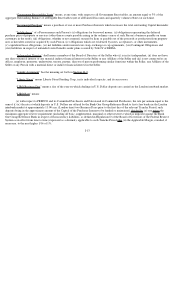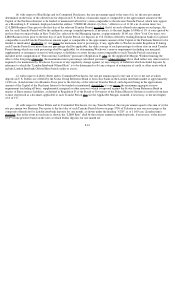McKesson 2005 Annual Report Download - page 283
Download and view the complete annual report
Please find page 283 of the 2005 McKesson annual report below. You can navigate through the pages in the report by either clicking on the pages listed below, or by using the keyword search tool below to find specific information within the annual report.-
 1
1 -
 2
2 -
 3
3 -
 4
4 -
 5
5 -
 6
6 -
 7
7 -
 8
8 -
 9
9 -
 10
10 -
 11
11 -
 12
12 -
 13
13 -
 14
14 -
 15
15 -
 16
16 -
 17
17 -
 18
18 -
 19
19 -
 20
20 -
 21
21 -
 22
22 -
 23
23 -
 24
24 -
 25
25 -
 26
26 -
 27
27 -
 28
28 -
 29
29 -
 30
30 -
 31
31 -
 32
32 -
 33
33 -
 34
34 -
 35
35 -
 36
36 -
 37
37 -
 38
38 -
 39
39 -
 40
40 -
 41
41 -
 42
42 -
 43
43 -
 44
44 -
 45
45 -
 46
46 -
 47
47 -
 48
48 -
 49
49 -
 50
50 -
 51
51 -
 52
52 -
 53
53 -
 54
54 -
 55
55 -
 56
56 -
 57
57 -
 58
58 -
 59
59 -
 60
60 -
 61
61 -
 62
62 -
 63
63 -
 64
64 -
 65
65 -
 66
66 -
 67
67 -
 68
68 -
 69
69 -
 70
70 -
 71
71 -
 72
72 -
 73
73 -
 74
74 -
 75
75 -
 76
76 -
 77
77 -
 78
78 -
 79
79 -
 80
80 -
 81
81 -
 82
82 -
 83
83 -
 84
84 -
 85
85 -
 86
86 -
 87
87 -
 88
88 -
 89
89 -
 90
90 -
 91
91 -
 92
92 -
 93
93 -
 94
94 -
 95
95 -
 96
96 -
 97
97 -
 98
98 -
 99
99 -
 100
100 -
 101
101 -
 102
102 -
 103
103 -
 104
104 -
 105
105 -
 106
106 -
 107
107 -
 108
108 -
 109
109 -
 110
110 -
 111
111 -
 112
112 -
 113
113 -
 114
114 -
 115
115 -
 116
116 -
 117
117 -
 118
118 -
 119
119 -
 120
120 -
 121
121 -
 122
122 -
 123
123 -
 124
124 -
 125
125 -
 126
126 -
 127
127 -
 128
128 -
 129
129 -
 130
130 -
 131
131 -
 132
132 -
 133
133 -
 134
134 -
 135
135 -
 136
136 -
 137
137 -
 138
138 -
 139
139 -
 140
140 -
 141
141 -
 142
142 -
 143
143 -
 144
144 -
 145
145 -
 146
146 -
 147
147 -
 148
148 -
 149
149 -
 150
150 -
 151
151 -
 152
152 -
 153
153 -
 154
154 -
 155
155 -
 156
156 -
 157
157 -
 158
158 -
 159
159 -
 160
160 -
 161
161 -
 162
162 -
 163
163 -
 164
164 -
 165
165 -
 166
166 -
 167
167 -
 168
168 -
 169
169 -
 170
170 -
 171
171 -
 172
172 -
 173
173 -
 174
174 -
 175
175 -
 176
176 -
 177
177 -
 178
178 -
 179
179 -
 180
180 -
 181
181 -
 182
182 -
 183
183 -
 184
184 -
 185
185 -
 186
186 -
 187
187 -
 188
188 -
 189
189 -
 190
190 -
 191
191 -
 192
192 -
 193
193 -
 194
194 -
 195
195 -
 196
196 -
 197
197 -
 198
198 -
 199
199 -
 200
200 -
 201
201 -
 202
202 -
 203
203 -
 204
204 -
 205
205 -
 206
206 -
 207
207 -
 208
208 -
 209
209 -
 210
210 -
 211
211 -
 212
212 -
 213
213 -
 214
214 -
 215
215 -
 216
216 -
 217
217 -
 218
218 -
 219
219 -
 220
220 -
 221
221 -
 222
222 -
 223
223 -
 224
224 -
 225
225 -
 226
226 -
 227
227 -
 228
228 -
 229
229 -
 230
230 -
 231
231 -
 232
232 -
 233
233 -
 234
234 -
 235
235 -
 236
236 -
 237
237 -
 238
238 -
 239
239 -
 240
240 -
 241
241 -
 242
242 -
 243
243 -
 244
244 -
 245
245 -
 246
246 -
 247
247 -
 248
248 -
 249
249 -
 250
250 -
 251
251 -
 252
252 -
 253
253 -
 254
254 -
 255
255 -
 256
256 -
 257
257 -
 258
258 -
 259
259 -
 260
260 -
 261
261 -
 262
262 -
 263
263 -
 264
264 -
 265
265 -
 266
266 -
 267
267 -
 268
268 -
 269
269 -
 270
270 -
 271
271 -
 272
272 -
 273
273 -
 274
274 -
 275
275 -
 276
276 -
 277
277 -
 278
278 -
 279
279 -
 280
280 -
 281
281 -
 282
282 -
 283
283 -
 284
284 -
 285
285 -
 286
286 -
 287
287 -
 288
288 -
 289
289 -
 290
290 -
 291
291 -
 292
292 -
 293
293 -
 294
294 -
 295
295 -
 296
296 -
 297
297 -
 298
298 -
 299
299 -
 300
300 -
 301
301 -
 302
302 -
 303
303 -
 304
304 -
 305
305 -
 306
306 -
 307
307 -
 308
308 -
 309
309 -
 310
310 -
 311
311 -
 312
312 -
 313
313 -
 314
314 -
 315
315 -
 316
316 -
 317
317 -
 318
318 -
 319
319 -
 320
320 -
 321
321 -
 322
322 -
 323
323 -
 324
324 -
 325
325 -
 326
326 -
 327
327 -
 328
328 -
 329
329 -
 330
330 -
 331
331 -
 332
332 -
 333
333 -
 334
334 -
 335
335 -
 336
336 -
 337
337 -
 338
338 -
 339
339 -
 340
340
 |
 |

“Credit and Collection Policy” means Seller’s credit and collection policies and practices relating to Contracts and Receivables
existing on the date hereof and summarized in Exhibit VIII hereto, as modified from time to time in accordance with this Agreement.
“Deemed Collections” means the aggregate of all amounts Seller shall have been deemed to have received as a Collection of a
Receivable. Seller shall be deemed to have received a Collection in full of a Receivable if at any time (i) the Outstanding Balance of any such
Receivable is either (x) reduced as a result of any defective or rejected goods or services, any discount or any adjustment or otherwise by Seller
(other than cash Collections on account of the Receivables) or (y) reduced or canceled as a result of a setoff in respect of any claim by any
Person (whether such claim arises out of the same or a related transaction or an unrelated transaction) or (ii) any of the representations or
warranties in Article IV are no longer true with respect to such Receivable.
“Defaulted Receivable ” means a Receivable: (i) as to which the Obligor thereof has taken any action, or suffered any event to occur,
of the type described in Section 8.1(d) (as if references to Seller Party therein refer to such Obligor); (ii) which, consistent with the Credit and
Collection Policy, would be written off Seller’s books as uncollectible, (iii) which has been identified by Seller as uncollectible in accordance
with the Credit and Collection Policy or (iv) as to which any payment, or part thereof, remains unpaid for ninety (90) days or more from the
original due date for such payment.
“Default Fee” means with respect to any amount due and payable by Seller in respect of any Aggregate Unpaids, an amount equal to
the greater of (i) $1000 and (ii) interest on any such unpaid Aggregate Unpaids at a rate per annum equal to 2% above the Base Rate.
“Default Proxy Ratio ” means, as of the last day of any Collection Period, a fraction (calculated as a percentage) equal to (i) the
aggregate gross debit Outstanding Balance of all Receivables (without duplication) which remain unpaid for more than sixty (60) but less than
ninety-one (91) or more days from the original due date at any time during the Collection Period then ending plus the aggregate Outstanding
Balance of all Receivables (without duplication) which, consistent with the Credit and Collection Policy, were or should have been written off
the Seller’s books as uncollectible and are less than ninety (90) days old during such period plus the aggregate Outstanding Balance of all
Receivables (without duplication) with respect to which the related Obligors are subject to a proceeding of the type described in Section 8.1(d)
but which have not yet been written off the Seller’s books as uncollectible, divided by (ii) the aggregate Outstanding Balance of all Receivables
generated during the Collection Period which ended three (3) Collection Periods prior to such last day.
“Delinquency Ratio” means, as of the last day of any Collection Period, a fraction (calculated as a percentage) equal to (i) the
aggregate Outstanding Balance of all Receivables that were Delinquent Receivables at such time and as of the last day of the two (2) preceding
Collection Periods by (ii) the sum of the aggregate Outstanding Balance of all Receivables as of the last day of each of such three
(3) Collection Periods.
“Delinquent Receivable ” means a Receivable as to which any payment, or part thereof, remains unpaid for sixty (60) days or more
from the original due date for such payment.
I-8
